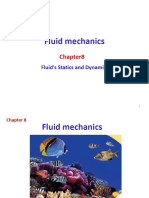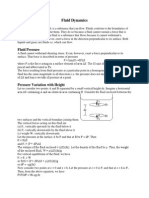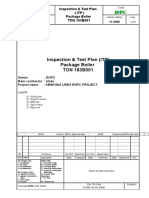Density or Specific Gravity
Density or Specific Gravity
Uploaded by
eldobie3Copyright:
Available Formats
Density or Specific Gravity
Density or Specific Gravity
Uploaded by
eldobie3Original Description:
Copyright
Available Formats
Share this document
Did you find this document useful?
Is this content inappropriate?
Copyright:
Available Formats
Density or Specific Gravity
Density or Specific Gravity
Uploaded by
eldobie3Copyright:
Available Formats
Density or Specific Gravity
The density or the specific gravity of a penetrant material probably has a slight to
negligible effect on the performance of a penetrant. The gravitational force acting on the
penetrant liquid can be working in cooperation with or against the capillary force
depending on the orientation of the flaw during the dwell cycle. When the gravitational
pull is working against the capillary rise the strength of the force is given by the
following equation:
Force = r2hpg
Where:
r = radius of the crack opening
h = height of penetrant above its free surface
p = density of the penetrant
g = acceleration due to gravity
When the direction of capillary flow is in the same direction as the force of gravity, the
added force driving the penetrant into the flaw is given by the formula shown below:
Force = hAp
Where:
h = the height of the penetrant column
A = cross-sectional area of the opening
P = density of the penetrant
Increasing the specific gravity by decreasing the volume percent of solvent in the solution
will increase the penetration speed.
Reference:
Tugrul, A. B., Capillarity Effect Analysis for Alternative Liquid Penetrant Chemicals,
NDT & E International, Volume 30 Number 1, Published by Elsevier Science Ltd.,
Oxford England, February 1997, pp. 19-23.
You might also like
- Api 510 Preparatory ExamDocument13 pagesApi 510 Preparatory Exameldobie3100% (1)
- 5b Density and PressuDocument8 pages5b Density and PressuSalman ShahidNo ratings yet
- Expression For Height in Capillary RiseDocument2 pagesExpression For Height in Capillary RiseSaad khanNo ratings yet
- MODULE 4 PROPERTIES OF MATTERDocument9 pagesMODULE 4 PROPERTIES OF MATTERabhinav200412No ratings yet
- P1 FluidMechanics1Document37 pagesP1 FluidMechanics1Kartikeyan PVJNo ratings yet
- Surface Tension (1)Document21 pagesSurface Tension (1)lamichhanetushar123No ratings yet
- Mechanical Properties of FluidsDocument5 pagesMechanical Properties of FluidsSteveMathewKuruvillaNo ratings yet
- Solution to be added.Document20 pagesSolution to be added.projectsNo ratings yet
- 14 Chapter Review - University Physics Volume 1Document30 pages14 Chapter Review - University Physics Volume 1harimecNo ratings yet
- Pressure in LiquidsDocument10 pagesPressure in LiquidsKulmat KadyrovNo ratings yet
- Mechanical Properties of Fluids Class 11 Notes Physics Chapter 10 - Learn CBSEDocument1 pageMechanical Properties of Fluids Class 11 Notes Physics Chapter 10 - Learn CBSEKabeer SananNo ratings yet
- The Physics of Fluids-2 PDFDocument20 pagesThe Physics of Fluids-2 PDFMellissa MungureNo ratings yet
- Viscous ForceDocument19 pagesViscous ForceJP AmarantoNo ratings yet
- Class XI: Physics Chapter 10: Mechanical Properties of FluidsDocument7 pagesClass XI: Physics Chapter 10: Mechanical Properties of Fluidschandramohan muruganNo ratings yet
- Packed N Fluidized BedDocument6 pagesPacked N Fluidized BedhariprakavNo ratings yet
- Mechanics of Liquids - 1Document5 pagesMechanics of Liquids - 1Rithik JayachandranNo ratings yet
- 2 Pressure PDFDocument16 pages2 Pressure PDFSahrEmmanuelJr.0% (1)
- Fluid Flow in Porous MediaDocument19 pagesFluid Flow in Porous MediaPaoLo AsequiaNo ratings yet
- Fluid Mechanism FinalDocument22 pagesFluid Mechanism Finalaaravv9336No ratings yet
- Lab 2 DrafDocument2 pagesLab 2 DrafTrương Thái Đức DươngNo ratings yet
- Fluid MechanicsDocument12 pagesFluid MechanicsAditya NandaNo ratings yet
- Phy1004w Buffler M&ie&m2Document41 pagesPhy1004w Buffler M&ie&m2tahermohNo ratings yet
- MO102 Lec-6 V2Document39 pagesMO102 Lec-6 V2Sheba SYNo ratings yet
- LEC.4 (Bio) Part 1 Fluid Mechanics 2324Document24 pagesLEC.4 (Bio) Part 1 Fluid Mechanics 2324sosoayman484No ratings yet
- PDF Copy AES Fluid Mechanics Pressure in Fluids BouyancyDocument44 pagesPDF Copy AES Fluid Mechanics Pressure in Fluids BouyancyknmagwateNo ratings yet
- Concepts of Water PotentialDocument67 pagesConcepts of Water Potentialsukhchain maanNo ratings yet
- Chapter14 Mekanika FluidaDocument50 pagesChapter14 Mekanika FluidaCandra AriWi BowoNo ratings yet
- Principles of Momentum Transfer and ApplicationsDocument9 pagesPrinciples of Momentum Transfer and ApplicationsjaiminNo ratings yet
- Chapter - 6 - Part-1 - Static - Fluids-1Document18 pagesChapter - 6 - Part-1 - Static - Fluids-1Khulud K. HabanjarNo ratings yet
- Grade 11 Mechanical Properties of FluidsDocument11 pagesGrade 11 Mechanical Properties of FluidsVipin VetriNo ratings yet
- Physical Pharmacy 5Document35 pagesPhysical Pharmacy 5Imran AmirNo ratings yet
- Phy2053 - 03 24 11Document25 pagesPhy2053 - 03 24 11Darwin GacutanNo ratings yet
- Pressure in LiquidsDocument18 pagesPressure in LiquidsNatasha54321No ratings yet
- 04 Forces 2022 Lecture Notes 5.18Document20 pages04 Forces 2022 Lecture Notes 5.18Candy MaNo ratings yet
- Fluid FrictionDocument10 pagesFluid FrictionUmesh PatilNo ratings yet
- Compressible Flow Through Convergent and Laval NozzlesDocument10 pagesCompressible Flow Through Convergent and Laval NozzlesIshwar SinghNo ratings yet
- FMHP1 (Week 2) : Engr. Muhammad Abdullah TariqDocument12 pagesFMHP1 (Week 2) : Engr. Muhammad Abdullah TariqAbcNo ratings yet
- Mechanical Properties of Fluids Class 11 Notes Physics Chapter 10 - Learn CBSEDocument6 pagesMechanical Properties of Fluids Class 11 Notes Physics Chapter 10 - Learn CBSEAjith kNo ratings yet
- Fluids in Motion DPSDocument12 pagesFluids in Motion DPSAurobinda MaharanaNo ratings yet
- Some SolutionsDocument22 pagesSome Solutionstaiyiguanglai45No ratings yet
- FluidsDocument7 pagesFluidssanketwanave5524No ratings yet
- Fluid DynamicsDocument24 pagesFluid DynamicsAnupam MNo ratings yet
- Unit 2-Fluid MechanicsDocument27 pagesUnit 2-Fluid MechanicsApechRanger100% (1)
- lecture-3(FM-1)_CDocument57 pageslecture-3(FM-1)_Csuhaibtarar58No ratings yet
- Fluidmechanicsnotes Statics 130308040222 Phpapp01Document21 pagesFluidmechanicsnotes Statics 130308040222 Phpapp01bdr363581No ratings yet
- Chapter5. PressureDocument35 pagesChapter5. PressureQIONG LIUNo ratings yet
- Notes - Topic 5 Forces, Density and Pressure - CAIE Physics A-LevelDocument5 pagesNotes - Topic 5 Forces, Density and Pressure - CAIE Physics A-LevelMahamIsmailNo ratings yet
- 06 Fluid Statics Theory IIDocument9 pages06 Fluid Statics Theory IIGAURAV KUMARNo ratings yet
- Turbulent Intensity PDFDocument2 pagesTurbulent Intensity PDFKimao LimNo ratings yet
- Mechanical Notes 4Document1 pageMechanical Notes 4shreyavinash1997No ratings yet
- Fluid Mech - ASSIGNMENTDocument3 pagesFluid Mech - ASSIGNMENTJoshua GrantNo ratings yet
- 6.pressure NewDocument13 pages6.pressure NewHafsah KhanNo ratings yet
- Flow of Fluids: Prepared By: Ankita Yagnik Assistant Professor Akshar-Preet Institute of Pharmacy, JamnagarDocument47 pagesFlow of Fluids: Prepared By: Ankita Yagnik Assistant Professor Akshar-Preet Institute of Pharmacy, JamnagarUrmit ParmarNo ratings yet
- Formation PressureDocument58 pagesFormation PressureJim Bode100% (1)
- Adsorption Coefficient - KRÜSS ScientificDocument2 pagesAdsorption Coefficient - KRÜSS ScientificRamirez FrancisNo ratings yet
- Flow Past Imm BodiesDocument26 pagesFlow Past Imm BodiesKshitij dalwadiNo ratings yet
- Report 7 Hydrostatic Pressure Lab Fis 102Document16 pagesReport 7 Hydrostatic Pressure Lab Fis 102ScribdTranslationsNo ratings yet
- Exam 1 Preparation Sheet.: ConversionsDocument4 pagesExam 1 Preparation Sheet.: ConversionskarthickNo ratings yet
- Method of Statement For Hydro Test ProcedureDocument11 pagesMethod of Statement For Hydro Test Procedureeldobie3100% (2)
- NDE PROCESS CONTROL Rev 1Document15 pagesNDE PROCESS CONTROL Rev 1eldobie3100% (1)
- Pene Trant Removal ProcessDocument3 pagesPene Trant Removal Processeldobie3No ratings yet
- Introduction and History of Penetrant Inspection: Capillary ActionDocument1 pageIntroduction and History of Penetrant Inspection: Capillary Actioneldobie3No ratings yet
- Developers: Developer FormsDocument3 pagesDevelopers: Developer Formseldobie3No ratings yet
- Preparation of PartDocument2 pagesPreparation of Parteldobie3No ratings yet
- Dimensional Threshold of FluorescenceDocument2 pagesDimensional Threshold of Fluorescenceeldobie3No ratings yet
- Common Uses of Liquid Pene Trant InspectionDocument2 pagesCommon Uses of Liquid Pene Trant Inspectioneldobie3No ratings yet
- PT BM 183 DC 00008 Preheat ProcedureDocument5 pagesPT BM 183 DC 00008 Preheat Procedureeldobie3No ratings yet
- Color and Fluorescent BrightnessDocument2 pagesColor and Fluorescent Brightnesseldobie3No ratings yet
- Pt-bm-g00-Dc-00101 Inspection and Test Plan For Piping Fabriction and ErectionDocument5 pagesPt-bm-g00-Dc-00101 Inspection and Test Plan For Piping Fabriction and Erectioneldobie3100% (1)
- PT BM 183 DC 00001 Itp BoilerDocument5 pagesPT BM 183 DC 00001 Itp Boilereldobie350% (2)
- Wps 06Document2 pagesWps 06eldobie3No ratings yet
- PT BM 183 DC 00007 PWHT ProcedureDocument7 pagesPT BM 183 DC 00007 PWHT Procedureeldobie3100% (1)
- API 510 PC 20 31 Aug05 Final Open AnswerDocument1 pageAPI 510 PC 20 31 Aug05 Final Open Answereldobie3No ratings yet
- I.E.M.S.A.: Welding Procedure SpecificationDocument2 pagesI.E.M.S.A.: Welding Procedure Specificationeldobie3No ratings yet
- I.E.M.S.A.: Welding Procedure SpecificationDocument2 pagesI.E.M.S.A.: Welding Procedure Specificationeldobie3No ratings yet
- Wps 06Document2 pagesWps 06eldobie3No ratings yet









































































